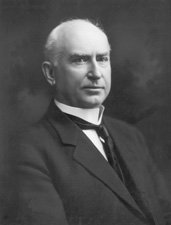James P. Clarke
James Paul Clarke | |
|---|---|
 | |
| President pro tempore of the United States Senate | |
| In office March 13, 1913 – October 1, 1916 | |
| Preceded by | Jacob H. Gallinger |
| Succeeded by | Willard Saulsbury, Jr. |
| United States Senator from Arkansas | |
| In office March 4, 1903 – October 1, 1916 | |
| Preceded by | James K. Jones |
| Succeeded by | William F. Kirby |
| 18th Governor of Arkansas | |
| In office January 8, 1895 – January 12, 1897 | |
| Preceded by | William Meade Fishback |
| Succeeded by | Daniel Webster Jones |
| Member of the Arkansas Senate | |
| In office 1888–1892 | |
| Member of the Arkansas House of Representatives | |
| In office 1886–1888 | |
| Personal details | |
| Born | August 18, 1854 Yazoo City, Mississippi |
| Died | October 1, 1916 (aged 62) Little Rock, Arkansas |
| Resting place | Oakland Cemetery |
| Political party | Democratic |
| Alma mater | University of Virginia |
| Profession | Lawyer |
James Paul Clarke (August 18, 1854 – October 1, 1916) was a United States Senator and the 18th Governor of Arkansas.
Biography
Clarke was born in Yazoo City, Mississippi. His father died when Clarke was seven years old, and he was raised by his mother. Clarke attended public schools as well as Tutwilder's Academy in Greenbrier, Alabama.[1] He graduated with a law degree at the University of Virginia in 1878. Clarke was admitted to the bar in 1879, and practiced law at Helena, Arkansas.
Career
Clarke served as a member of the Arkansas House of Representatives from 1886 to 1888. He became a member of the Arkansas Senate from 1888 to 1892, and served as president of the Senate in 1891.

Clarke was elected Attorney General of Arkansas and served from 1892 to 1894. He served as Governor of Arkansas from 1895 to 1897.[2] His term was largely unsuccessful and his legislation to end prizefighting and establish four year terms for state officers failed. After leaving office in 1897, he moved his permanent residence to Little Rock, Arkansas and practiced law.
Clarke was elected to the United States Senate in 1903, and served until his death in 1916. He served as President pro tempore of the United States Senate during the Sixty-third and Sixty-fourth Congresses.
Death and legacy
Clarke died in Little Rock, Arkansas. He is buried at Oakland Cemetery in Little Rock.
Clarke's statue is one of two statues that was presented by the State of Arkansas to the National Statuary Hall Collection at the United States Capitol.
See also
References
- ^ "James Paul Clarke (1895–1897)". Old State House Museum. Archived from the original on November 14, 2012. Retrieved August 17, 2012.
{{cite web}}: Unknown parameter|deadurl=ignored (|url-status=suggested) (help) - ^ "Arkansas Governor James Paul Clarke". National Governors Association. Retrieved August 17, 2012.
External links
- Encyclopedia of Arkansas History & Culture entry: James Paul Clarke
- United States Congress. "James P. Clarke (id: C000463)". Biographical Directory of the United States Congress.
- James P. Clarke at Find a Grave
- Old State House Museum
- James P. Clarke, late a senator from Arkansas, Memorial addresses delivered in the House of Representatives and Senate frontispiece 1917
- Arkansas lawyers
- Governors of Arkansas
- Arkansas state senators
- Members of the Arkansas House of Representatives
- 1854 births
- 1916 deaths
- People from Yazoo City, Mississippi
- United States Senators from Arkansas
- Arkansas Democrats
- University of Virginia School of Law alumni
- Arkansas Attorneys General
- Democratic Party United States Senators
- Democratic Party state governors of the United States
- 19th-century American politicians
- Presidents pro tempore of the United States Senate
- People whose statue is in the National Statuary Hall Collection




